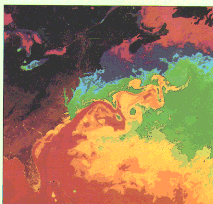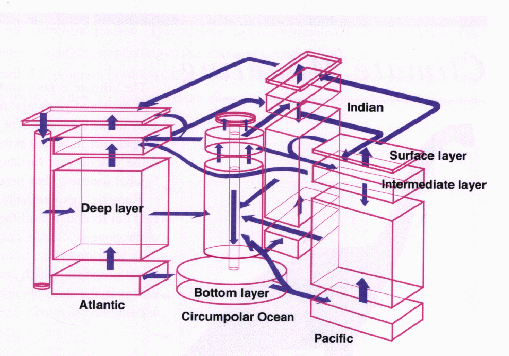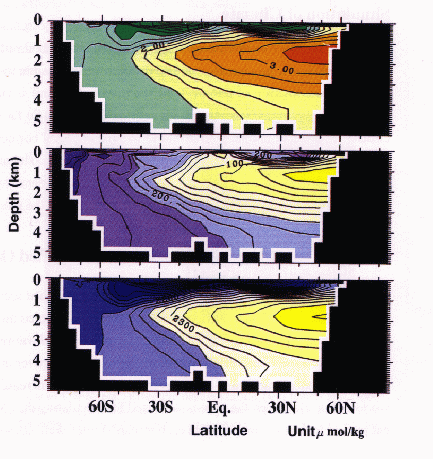 Ocean Modeling
Ocean Modeling
The ocean, which covers 70% of the earth's surface, absorbs solar
energy and releases heat and vapor into the atmosphere and is a source of
dynamical energy in the atmosphere. Greenhouse gases such as carbon dioxide
are also dissolved in the ocean, and concentrations of such gases are
determined by exchange between the atmosphere and the ocean. The heat and
dissolved gases bring about important interactions with the living
organisms in the ocean. Understanding of this massive ocean is
indispensable for understanding the climate system. This is the goal of
the Ocean Modeling Group.
 Research subjects
Research subjects
Interaction between mesoscale eddies and the general circulation
The role of the Antarctic Circumpolar Ocean in the general circulation
Formation processes of deep water and bottom water
Parameterization of mixing
The carbon cycle in the ocean
 Present Status of Understanding of the General Circulation and Prospects
Present Status of Understanding of the General Circulation and Prospects

The general circulation can be divided into two parts in terms of the
forcing agents, the wind-driven circulation brought about by surface wind,
and the thermohaline circulation caused by regional differences of heat and
water budget through the sea surface. For convenience, we call the
thermocline where the water temperature suddenly drops, the intermediate
layer; above it, the surface layer; and below it, the deep layer. It is
believed that in the surface layer, the wind-driven circulation is
predominant; and in the deep layer, the thermohaline circulation dominates,
and in the intermediate layer, these circulations compete. Compared to
the surface layer, the circulation in the intermediate and deep layers is
unknown due to the difficulties in observation. For example, in the deep
water, the average speed of flow is less than 1cm/sec, too small to be
directly measured, and mesoscale eddies with diameters of 100~400km exist
everywhere in the oceans from the surface to the bottom.
 [Fig.1]Schematic Figure of General Circulation
[Fig.1]Schematic Figure of General Circulation
Figure 1 shows schematically the general circulation deduced from the
observed distributions of tracers such as salinity, dissolved oxygen, freon
and various isotopes, and through theoretical study of the wind-driven
circulation and thermohaline circulation. As shown in the figure, the
ocean is divided into four layers, each of which has a different
circulation. Our aim is to obtain an accurate picture of the general
circulation and to construct a model of it. In order to verify the model,
we are now undertaking comparative studies of data acquired from TOGA and WOCE. Obtaining a better picture of ocean circulation through such
comparisons is one of the most important goals of the group (Fig. 2).
 [Fig.2]Distributions Of Various Tracers In The Pacific Calculated By Using CCSR OGCM.From The Top,Phosphate,Dissolved Oxygen And Total Dissolved Inorganic Carbon.
[Fig.2]Distributions Of Various Tracers In The Pacific Calculated By Using CCSR OGCM.From The Top,Phosphate,Dissolved Oxygen And Total Dissolved Inorganic Carbon.
 General Circulation Model
General Circulation Model
กก The mathematical equation describing the general circulation is simple compared to that of the atmosphere since it doesn't include cloud or
radiation processes. The same can be said for sea ice, whose thermodynamic
process is comparatively simple. On the other hand, phenomena at various
time and space scales co-exist in the ocean and interaction among them is
very strong, and the most important issue is how to parameterize phenomena
smaller than the grid resolution. Since the geographical features of
coasts and ocean floors are so complex and there exists stratification
closely related to the circulation, it is necessary to utilize a variety of
means in solving these equations. Furthermore, in order to study global
climate variability, we must treat together all the oceans connected by
Antarctic Circumpolar Ocean. In such a large-scale system, various
time-scale phenomena occur in the complex manner described above, and
enormous computer time is necessary. The horizontal grid resolution may
only reach one degree by the end of this century due to present computing
ability . We must therefore continue basic studies of parameterization of
phenomena which cannot be described by such grid spacing. Parameterizing
small-scale mixing processes of various origins is necessary, and
understanding of the interaction between mesoscale eddies and the general
circulation is indispensable.

return to Index
return to CCSR homepage
 Ocean Modeling
Ocean Modeling Ocean Modeling
Ocean Modeling Research subjects
Research subjects Present Status of Understanding of the General Circulation and Prospects
Present Status of Understanding of the General Circulation and Prospects
 [Fig.1]Schematic Figure of General Circulation
[Fig.1]Schematic Figure of General Circulation
 [Fig.2]Distributions Of Various Tracers In The Pacific Calculated By Using CCSR OGCM.From The Top,Phosphate,Dissolved Oxygen And Total Dissolved Inorganic Carbon.
[Fig.2]Distributions Of Various Tracers In The Pacific Calculated By Using CCSR OGCM.From The Top,Phosphate,Dissolved Oxygen And Total Dissolved Inorganic Carbon.
 General Circulation Model
General Circulation Model